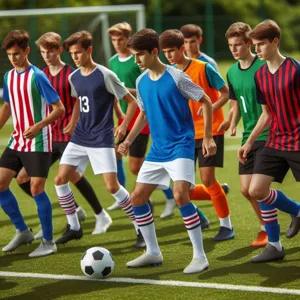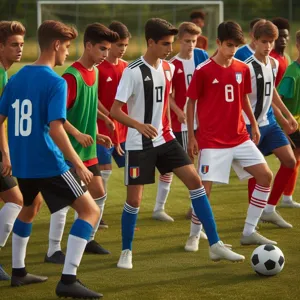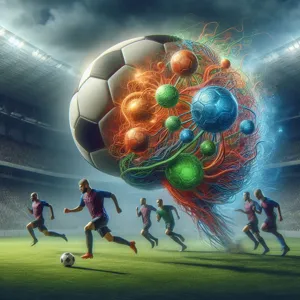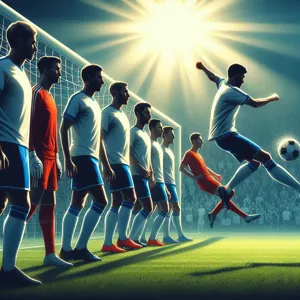As the excitement of the upcoming soccer match builds, every player and coach understands that success on the pitch is not just about talent and teamwork; it’s also about meticulous preparation.
Mastering the pitch requires a blend of physical readiness, tactical awareness, and mental fortitude. In “Mastering the Pitch: The Ultimate Guide to Soccer Match Preparation,” we delve into the essential strategies that can elevate your game and ensure you step onto the field with confidence. From crafting the perfect warm-up routine to analyzing your opponents and honing your game-day mindset, this comprehensive guide offers invaluable insights and practical tips for players of all levels. Whether you’re a seasoned athlete or just starting your soccer journey, understanding the nuances of match preparation can be the difference between victory and defeat. Join us as we explore the keys to being fully prepared and ready to unleash your best performance when it matters most!
1. Understanding the Importance of Match Preparation

Understanding the importance of match preparation is the cornerstone of achieving success on the soccer field. Preparation goes beyond mere drills and tactical discussions; it encompasses a holistic approach that integrates physical fitness, mental readiness, and tactical awareness. When players and coaching staff prioritize preparation, they lay a solid foundation for performance, ensuring that every individual is physically and mentally equipped to face the challenges that come with competitive play.
The stakes in a soccer match are high, and even the slightest edge can make the difference between victory and defeat. Thorough match preparation allows teams to familiarize themselves with not only their strategies but also the strengths and weaknesses of their opponents. This insight can significantly boost confidence levels, as players enter the field knowing they are well-prepared for whatever may come their way.
Moreover, effective match preparation fosters team cohesion. When players engage in collective training sessions, they build trust and understanding, enhancing their ability to work together seamlessly during the game. The camaraderie developed through this preparation creates a supportive environment where players feel empowered to communicate effectively and make split-second decisions on the pitch.
From the meticulous planning of training schedules to the analysis of previous matches, the nuances of match preparation are pivotal. Attention to detail matters; whether it’s perfecting set pieces, refining defensive formations, or ensuring players are mentally focused through visualization techniques, every element contributes to a team’s overall readiness.
As we explore the various facets of soccer match preparation, it becomes clear that investing time and energy into this process not only maximizes performance but also instills a winning mindset that players can carry throughout their careers. In the world of soccer, being prepared is not just an option—it’s a necessity for achieving greatness.
2. Analyzing the Opposition: Key Strategies
Analyzing the opposition is a crucial step in preparing for a soccer match, as understanding your competitors can provide invaluable insights that can influence your game plan. Before stepping onto the pitch, it’s essential to gather and interpret data about the other team’s strengths, weaknesses, tactical formations, and key players. This analysis isn’t just about knowing who you’re up against; it’s about crafting a strategy that leverages your team’s abilities while exploiting the opposition’s vulnerabilities.
Start by reviewing game footage from previous matches. Look for patterns in their play—how they transition from defense to attack, their preferred formations, and how they respond under pressure. Pay attention to standout players: who are their playmakers, who takes the most shots, and who is responsible for set pieces? Understanding these elements can help you prepare specific tactics to neutralize their strengths and capitalize on their weaknesses.
Additionally, consider conducting a SWOT analysis (Strengths, Weaknesses, Opportunities, Threats) for the opposing team. This structured approach will help you clearly outline what the other team excels at, where they falter, potential openings you can exploit, and external factors that could affect performance, such as weather conditions or injury reports.
Engage your players in this analysis process; discussing strategies and insights as a team fosters a collaborative environment and empowers everyone to contribute to the game plan. Encourage open dialogue about match tactics in training sessions, allowing players to voice their thoughts and ideas based on their observations. This collective intelligence can lead to a more cohesive and dynamic approach on match day.
Ultimately, analyzing the opposition equips your team with the knowledge and confidence needed to adapt and respond effectively during the game, setting the stage for success on the pitch. With a well-prepared strategy based on thorough analysis, you’ll be better positioned to outmaneuver your rivals and secure victory.
3. Setting Goals: Individual and Team Objectives

Setting goals is a fundamental aspect of successful soccer match preparation, both for individual players and the team as a whole. Without clear objectives, it’s easy to lose focus and direction, making it crucial to outline what you hope to achieve in the lead-up to the game.
For individual players, goal-setting should be specific, measurable, attainable, relevant, and time-bound (SMART). Perhaps a defender wants to improve their passing accuracy to 85% or a striker aims to score at least one goal in the upcoming match. These personal benchmarks not only enhance a player’s performance but also contribute to the collective success of the team. Encouraging players to reflect on their strengths and weaknesses can also foster personal accountability and motivation.
On the team level, establishing collective goals is equally essential. These can range from tactical objectives—like maintaining possession for a certain percentage of the game or executing a specific formation—to broader aims such as improving team chemistry or enhancing defensive strategies. Having a unified vision can galvanize the entire squad, creating a sense of purpose and camaraderie as everyone rallies towards a common objective.
Additionally, it’s important to revisit and adjust these goals throughout the season. Regular check-ins after matches allow players and coaches to assess what was achieved, identify areas for improvement, and re-calibrate their aims based on performance and changing circumstances. By fostering an environment where both individual and team objectives are prioritized, players can approach each match not just as a competition, but as a valuable opportunity for growth and development.
Ultimately, setting clear goals acts as a roadmap, guiding your preparations and keeping everyone aligned as you strive for success on the pitch. When players know what they’re aiming for, they can channel their efforts more effectively, leading to enhanced performance and, ultimately, better results.
4. Developing a Training Regimen: Building Fitness and Skill
In the world of soccer, success on match day hinges significantly on the training regimen you establish leading up to the big game. Developing a comprehensive training program is not just about building fitness; it’s about honing the skills that will give your team the competitive edge. A well-structured regimen combines physical conditioning, technical drills, tactical awareness, and mental preparation, ensuring every player is primed for peak performance.
Start by assessing the physical fitness levels of your squad. Incorporate a mix of endurance, strength, speed, and agility training to ensure players can withstand the demands of a full match. High-intensity interval training (HIIT) can be particularly effective, pushing players to elevate their cardiovascular fitness while simulating the bursts of energy required during gameplay. Additionally, strength training sessions focusing on core stability and leg power will enhance players’ abilities to tackle, sprint, and maintain balance under pressure.
Equally important is the technical skill development aspect of training. Regular drills focusing on passing, dribbling, shooting, and ball control are vital. Incorporate game-like scenarios to challenge your players and foster decision-making skills. For instance, setting up small-sided games can encourage quick thinking and promote teamwork, as players learn to communicate and collaborate effectively on the field.
Tactical awareness cannot be overlooked. Conduct video analysis sessions where players can study previous matches, identify strengths and weaknesses, and understand the strategies they’ll employ against their upcoming opponents. This will not only enhance their understanding of the game but also instill confidence in their ability to execute tactics during matches.
Lastly, don’t forget the mental aspect of preparation. Encourage mindfulness and visualization techniques that allow players to mentally rehearse their performance. Building a team culture that emphasizes resilience, focus, and positivity can have profound effects on players’ mentality as they approach the pitch.
By developing a training regimen that balances fitness and skill, you’re not just preparing your team for a match; you’re laying the foundation for a successful season. The commitment to rigorous training will cultivate a strong, unified team ready to face any challenge head-on.
5. The Role of Nutrition in Match Preparation

Nutrition plays a pivotal role in soccer match preparation, serving as the foundation upon which athletes build their performance. As players lace up their cleats and step onto the pitch, the energy and focus required for success are largely influenced by the fuel they’ve consumed in the days leading up to the match.
A well-balanced diet tailored to the specific needs of soccer can enhance stamina, strength, and overall performance. Carbohydrates are the cornerstone of any pre-match meal plan; they provide the necessary energy reserves for high-intensity bursts of speed and endurance throughout the game. Complex carbohydrates, such as whole grains, fruits, and vegetables, should be prioritized in the days before a match, ensuring players have a steady release of energy.
Proteins also play a key role, aiding in muscle repair and recovery. Lean meats, fish, eggs, and plant-based proteins should be included to help players maintain peak physical condition. Meanwhile, healthy fats, found in nuts, seeds, and avocados, support overall health and should not be neglected.
Hydration is equally crucial. Dehydration can lead to fatigue, decreased coordination, and impaired decision-making—all critical elements in a competitive match. Players should start hydrating well before game day, consuming plenty of fluids and incorporating electrolyte-rich drinks to replenish lost salts.
On the day of the match, timing and portion sizes are vital. A well-timed meal—rich in carbohydrates with a moderate amount of protein—2-3 hours before kickoff can set the stage for peak performance. Additionally, quick snacks such as bananas or energy bars can be beneficial for a last-minute energy boost just before the whistle blows.
In summary, mastering the art of nutrition not only supports physical readiness but also fosters mental sharpness. By prioritizing the right foods and hydration strategies, players can ensure they’re not just physically prepared, but also mentally ready to take on their opponents with confidence and vigor.
6. Mental Preparation: Building Confidence and Focus
When it comes to soccer match preparation, mental readiness is just as crucial as physical conditioning. The right mindset can be the difference between a good performance and an exceptional one, making mental preparation a key element in your pre-match routine. Building confidence and focus not only enhances individual performance but also positively influences the entire team dynamic.
Begin by setting clear, achievable goals for the match. Visualizing success can significantly boost your self-assurance. Picture yourself executing key plays, making strategic passes, and celebrating goals. This mental imagery reinforces your abilities and instills a sense of belief in your skills. As you visualize these scenarios, consider reflecting on past successes—think of matches where you played at your best. Reminding yourself of these moments can serve as a powerful confidence booster.
In addition to visualization, mindfulness practices such as deep breathing and meditation can help sharpen your focus. Take a few moments before the match to find a quiet space where you can center your thoughts. Close your eyes, breathe deeply, and concentrate on the rhythm of your breath. This practice not only calms the mind but also helps clear any negative thoughts, allowing you to enter the match with a positive and determined attitude.
Another effective strategy is to develop a pre-game routine. This could include listening to your favorite pump-up music, engaging in light stretching, or even having a motivational chat with teammates. A consistent routine prepares your mind for the game ahead while fostering a sense of camaraderie among players.
Lastly, remember the importance of self-talk. The narratives we tell ourselves can shape our perceptions and attitudes. Replace negative thoughts like “I might mess up” with affirmations like “I am prepared and capable.” This shift in language transforms anxiety into empowerment, paving the way for a confident and focused performance on the field.
By prioritizing mental preparation, you set the stage for success, allowing your physical skills to shine through and enhancing your overall game experience. Embrace the power of your mind—it’s an invaluable tool that can propel you toward victory.
7. Equipment Check: What to Bring to the Pitch

When it comes to soccer match preparation, the equipment check can make or break your performance on the pitch. Arriving at the game fully equipped ensures that you can focus solely on your performance instead of worrying about what you might have forgotten. Here’s a detailed breakdown of what to bring, ensuring you’re ready to give it your all.
**1. Essential Gear:** At the forefront of your packing list should be your soccer kit—this includes your jersey, shorts, and socks. Make sure to have your cleats ready, as they provide the necessary traction on the field. It’s also wise to bring an extra pair in case the weather turns or your current pair doesn’t feel right.
**2. Shin Guards:** Protecting your legs is crucial. Don’t forget to pack your shin guards, as they are essential for safety during the match. Check to ensure they fit properly, providing both comfort and protection.
**3. Water and Hydration Supplies:** Staying hydrated is key to peak performance. Bring along a water bottle filled with water or an electrolyte drink. If the match is long or the weather is particularly hot, consider bringing a cooler with extra drinks to share with teammates.
**4. Personal Items:** Depending on your needs, you might want to include personal items such as a towel, sunscreen for sunny days, and even a change of clothes for after the game. Keep a small first-aid kit handy for minor injuries or scrapes that can occur during play.
**5. Training Aids:** If you’re someone who likes to warm up or practice before the match, consider bringing along a ball for some last-minute touches, cones for dribbling drills, or resistance bands for stretching. These tools can aid in getting your body ready for the game ahead.
**6. Snacks:** Energy-boosting snacks like granola bars, bananas, or energy gels can help maintain your stamina. Having a small supply of quick energy can make a significant difference, especially during intense matches.
**7. Game Strategy Notes:** If you’re someone who likes to strategize, jot down key points or plays to remember. Keeping these notes in your bag can help you mentally prepare and focus on your game plan.
By meticulously checking off this equipment list before you head to the pitch, you’ll ensure that you have everything needed for a successful match. Preparation breeds confidence, and with the right gear in hand, you can focus on what truly matters: playing your best game.
8. Pre-Match Warm-Up Routines
The pre-match warm-up routine is a critical component of soccer match preparation that can significantly influence a player’s performance on the field. This phase is not just about getting the blood pumping; it’s a holistic approach to readying both the body and mind for the intensity of the game ahead.
A well-structured warm-up typically begins with a light jog around the field to elevate heart rates and increase blood flow to the muscles. This initial phase should be followed by dynamic stretching exercises, such as leg swings, high knees, and butt kicks, that promote flexibility and help prevent injuries. These movements are crucial, as they mimic the motions players will perform during the match, preparing the muscles for the rigorous demands ahead.
Incorporating ball work into the warm-up routine is equally important. Players should engage in drills that focus on passing, dribbling, and shooting. This not only sharpens their technical skills but also allows them to connect with their teammates, fostering a sense of camaraderie and teamwork before the whistle blows. Coaches often emphasize the importance of communication during these drills, setting the tone for collaboration on the field.
Mental preparation cannot be overlooked during the warm-up. As players stretch and move, they should also be visualizing their roles in the game, strategizing their plays, and getting in the right mindset to tackle the challenges they will face. Fostering a positive and focused atmosphere in the warm-up area can help ease nerves and build confidence.
Finally, concluding the warm-up with a team huddle can serve as a motivational boost. This moment allows players to motivate one another, establish a collective goal, and mentally affirm their readiness.
By adhering to a consistent and thorough pre-match warm-up routine, players not only enhance their physical readiness but also cultivate the mental fortitude necessary to excel on the pitch. As they step onto the field, they carry with them the benefits of preparation, ensuring they’re fully equipped to give their best performance.
9. Creating a Game Plan: Formation and Tactics
Creating a game plan is a pivotal step in preparing for a soccer match, as it sets the stage for how your team will approach the game. A well-thought-out formation and a clear set of tactics can make all the difference in the outcome on the pitch.
First, consider the strengths and weaknesses of your squad. Are you blessed with quick, agile players who thrive on fast breaks, or do you have a more physically robust team that excels in winning aerial duels? Choosing the right formation—be it a classic 4-4-2, a dynamic 4-3-3, or a more defensive 5-3-2—should reflect the unique characteristics of your players. A formation sets the foundation for your tactical approach, dictating how players will position themselves, transition between defense and attack, and communicate during the game.
Once you’ve established your formation, it’s time to delve into the tactics. This encompasses how you want your team to play, including pressing strategies, defensive structures, and attacking movements. For instance, if you’re going up against a team known for their possession-oriented style, you might opt for a high-pressing tactic to disrupt their rhythm and force turnovers in dangerous areas. Conversely, if you’re facing a dominant attacking side, a more compact defensive shape with quick counterattacks can be your best approach.
Moreover, don’t forget to prepare specific set-piece strategies. Corner kicks and free kicks can be game-changers, so having designated routines can give you an edge. Discuss with your players their roles during these moments, ensuring that everyone is clear on their responsibilities.
In addition to the tactical preparations, instilling a mindset of adaptability is essential. Soccer is unpredictable, and being able to adjust your game plan mid-match—whether to counteract an opposing player’s brilliance or to seize an unexpected opportunity—can be the key to victory.
By meticulously crafting your game plan with a focus on formation and tactics, you not only prepare your team for the challenges ahead but also instill confidence and clarity that can carry them through to a successful match day.
10. The Importance of Team Communication
In the high-stakes world of soccer, where every second counts and split-second decisions can determine the outcome of a match, effective team communication stands as a cornerstone of success. It’s not just about shouting instructions or calling for the ball; it’s about creating a cohesive unit that operates seamlessly on the field. The importance of team communication cannot be overstated—it fosters trust, enhances strategy execution, and ultimately drives performance.
Before the match, teams should engage in open discussions to clarify roles, strategies, and expectations. Whether it’s a tactical shift or a simple reminder of set-piece responsibilities, ensuring that every player is on the same page prepares the squad for the unexpected twists of the game. This pre-match dialogue lays the groundwork for fluid communication during the match itself.
During the game, verbal cues, hand signals, and even body language become vital tools for players. A well-timed shout can alert a teammate to an opposing player’s presence, while a simple nod can confirm that a pass is on the way. The ability to communicate quickly and effectively allows players to adapt to changing situations, whether it’s moving to cover a defensive gap or making a run for goal.
Moreover, strong communication helps to build camaraderie and morale. When players feel comfortable expressing themselves, they develop a deeper connection with one another, which can translate into more coordinated and instinctive play. Coaches can facilitate this by encouraging a culture of openness and teamwork during training sessions, where players practice not just their technical skills, but also their ability to convey information and support one another.
In essence, effective team communication is a dynamic and ongoing process that is essential for soccer match preparation. It empowers players to make informed decisions, supports strategic execution, and cultivates a spirit of unity that can propel a team to victory. As teams hone their communication skills, they not only prepare for the match ahead but also strengthen their overall team dynamics, paving the way for long-term success on the field.
11. Pre-Match Visualization Techniques
Pre-match visualization techniques are a powerful tool that can elevate a player’s performance, instilling confidence and clarity before stepping onto the field. This practice involves mentally rehearsing game scenarios, allowing athletes to envision success and prepare for various situations they might encounter during the match.
To begin, find a quiet space where you can focus without distractions. Close your eyes and take a few deep breaths to center yourself. Visualize the stadium filled with fans, the sound of cheering echoing in your ears, and the palpable excitement in the air. Imagine yourself walking onto the field, feeling the grass beneath your cleats and the weight of your jersey as you prepare for the game ahead.
As you delve deeper into your visualization, picture specific moments from the match. Envision yourself making crucial passes, executing perfect tackles, or scoring a game-winning goal. The more vivid and detailed your mental images, the more effective the visualization will be. Incorporate all your senses; hear the thud of the ball, feel the rush of adrenaline, and see the expressions on your teammates’ and opponents’ faces.
Additionally, consider visualizing both positive outcomes and potential challenges. This technique, often referred to as “positive mental imagery,” helps you prepare for various scenarios, enabling you to develop strategies for overcoming obstacles during the match. For instance, if you foresee a tough defensive player, visualize how you will maneuver around them or communicate with your teammates to create opportunities.
Practicing visualization regularly—ideally in the days leading up to the match—can significantly boost your mental readiness. Many professional athletes swear by this technique, noting that it not only enhances focus but also reduces pre-game anxiety. By mastering pre-match visualization techniques, you’ll not only sharpen your mental game but also set yourself up for a successful performance on the pitch, fully prepared to tackle any challenge that arises.
12. Recovery Strategies Post-Match
Recovery strategies post-match are crucial for maintaining peak performance and ensuring that players bounce back swiftly after the intense physical demands of a soccer game. The moments that follow the final whistle are just as important as the hours spent training and strategizing. A well-rounded recovery plan not only aids in physical recuperation but also helps in mental rejuvenation, setting the stage for future successes on the field.
First and foremost, hydration plays a vital role in recovery. After a match, players should replenish fluids lost through sweat to prevent dehydration, which can lead to fatigue and impair performance in subsequent games. Drinking water is essential, but incorporating electrolyte-rich sports drinks can further aid in restoring lost minerals.
Next, nutrition is key. Consuming a balanced meal rich in carbohydrates and proteins within two hours post-match helps in muscle recovery and energy replenishment. Foods such as lean meats, whole grains, and plenty of fruits and vegetables can provide the necessary nutrients to repair muscle tissues and restore glycogen levels.
Stretching and cool-down exercises are also imperative. Engaging in light stretching post-match helps to increase blood flow to the muscles, reducing soreness and stiffness. Implementing techniques such as foam rolling can alleviate muscle tightness and enhance flexibility, making it easier for players to prepare for their next training session.
In addition to physical recovery, mental recovery should not be overlooked. Taking time to reflect on the match—analyzing what went well and what could be improved—can help players mentally process the game’s events. Engaging in mindfulness or relaxation techniques, such as deep breathing or meditation, can also aid in reducing stress and enhancing focus for future matches.
Lastly, incorporating rest and sleep into the recovery strategy cannot be emphasized enough. Quality sleep is when the body does much of its healing and repair work. Encouraging players to prioritize sleep in the days following a match will help ensure they are physically and mentally prepared for their next challenge.
In summary, effective post-match recovery strategies—encompassing hydration, nutrition, stretching, mental reflection, and adequate rest—are essential for soccer players looking to master their performance. By prioritizing recovery, players can enhance their resilience, ensure longevity in their careers, and maintain the highest level of competitive play.
13. Learning from Each Game: Reviewing Performance
Reviewing performance after each game is an essential step in mastering the pitch and elevating your team’s overall capability. This process goes beyond merely checking the scoreline; it’s about delving into the intricacies of your team’s tactics, individual player performances, and overall cohesion on the field.
Begin by gathering all relevant data from the match—statistics such as possession percentages, pass completion rates, and shot accuracy provide a quantitative overview of how well your team executed its game plan. However, numbers alone don’t tell the whole story. Watching game footage allows you to analyze key moments, both good and bad. Look for patterns that emerged during the match: Did the team’s formation hold strong against the opponent’s attacks? Were players making the right decisions under pressure?
Incorporate feedback from all players, encouraging an open dialogue about what they felt worked and what didn’t. This not only helps in identifying areas for improvement but also fosters a collaborative environment where players feel valued and invested in their development. Highlighting specific instances where players exhibited exceptional skill or teamwork can boost morale and motivate them to maintain high performance levels.
As you review, focus on setting clear, actionable goals for the next game. Whether it’s improving communication on the field, enhancing defensive strategies, or sharpening finishing skills in front of the goal, having a targeted approach will guide your training sessions and keep the team focused on continuous improvement.
By consistently reviewing performances and learning from each game, your team not only becomes more adept at adapting to different opponents but also builds a resilient mindset that thrives on growth and excellence. Remember, every match is an opportunity to learn, and by embracing this mindset, you prepare your team not just for the next game, but for a successful season ahead.
14. Building Team Chemistry: The Social Aspect of Preparation
Building team chemistry is a crucial, yet often overlooked, aspect of match preparation that can significantly impact performance on the pitch. Soccer is as much a mental game as it is a physical one, and fostering strong relationships among players can lead to improved communication, trust, and synergy during a match.
To cultivate this essential team dynamic, consider organizing social activities outside the usual training sessions. Whether it’s team dinners, bonding retreats, or casual outings, these experiences allow players to connect on a personal level, breaking down barriers that may exist in a competitive environment. When teammates understand each other’s personalities and communication styles, they can anticipate each other’s movements and decisions during the heat of a match, enhancing overall teamwork.
Additionally, incorporating team-building exercises into your training routine can be incredibly beneficial. Activities that require collaboration, such as obstacle courses or trust falls, not only build camaraderie but also help players learn to rely on one another. When players share challenges and celebrate successes together, they forge memories that translate into a stronger, more cohesive unit on the field.
Moreover, consider implementing regular team meetings where players can voice their thoughts and ideas. This open line of communication fosters a sense of belonging and respect, making each player feel valued and more invested in the team’s success. When players feel connected, they’re more likely to push each other to improve, leading to a more motivated squad.
Ultimately, the social aspect of preparation should not be underestimated. By prioritizing team chemistry, you create an environment where players are inspired to give their all, both for themselves and their teammates. This sense of unity not only enhances performance during matches but also builds a lasting legacy that extends beyond the pitch.
15. Conclusion: Continuous Improvement and Adaptability
In the world of soccer, as in any competitive arena, the only constant is change. The conclusion of our guide on mastering match preparation emphasizes the paramount importance of continuous improvement and adaptability. As players and coaches, it is essential to recognize that no two matches are alike; each opponent presents a unique challenge that requires a fresh approach.
Embracing a mindset of lifelong learning is crucial. After every match, whether you secure a victory or experience a setback, take the time to analyze your performance critically. What strategies worked well? Where did the team struggle? Utilize game footage and statistical analysis to identify patterns and areas for growth. Feedback from coaches, teammates, and even opponents can offer valuable insights that contribute to individual and team development.
Moreover, adaptability is key to thriving in the dynamic environment of soccer. As the game evolves—whether through rule changes, advancements in training techniques, or shifts in playing styles—so too must your preparation. This might mean experimenting with new formations, enhancing your physical conditioning, or incorporating innovative technology into your training regimen.
By cultivating a culture of continuous improvement and remaining open to adaptation, players and teams can stay ahead of the curve and maintain a competitive edge. Remember, the most successful teams are those that not only prepare rigorously for each match but also evolve in response to the challenges they encounter. So, as you step onto the pitch, carry with you the commitment to learn, grow, and adapt—this is the essence of mastering the art of soccer match preparation.
In conclusion, mastering the pitch and preparing for a soccer match involves a comprehensive approach that combines physical conditioning, strategic planning, and mental fortitude. By following the steps outlined in our ultimate guide, from analyzing your opponent to refining your warm-up routine, you can elevate your game and boost your team’s performance. Remember, preparation is not just about the hours spent on the field; it’s also about the dedication you show off the pitch. As you implement these strategies, you’ll not only enhance your skills but also build confidence that translates into success during match day. Embrace the journey, stay focused, and watch as your efforts lead to victorious moments on the field. Now, lace up your cleats and get ready to conquer the pitch!




































